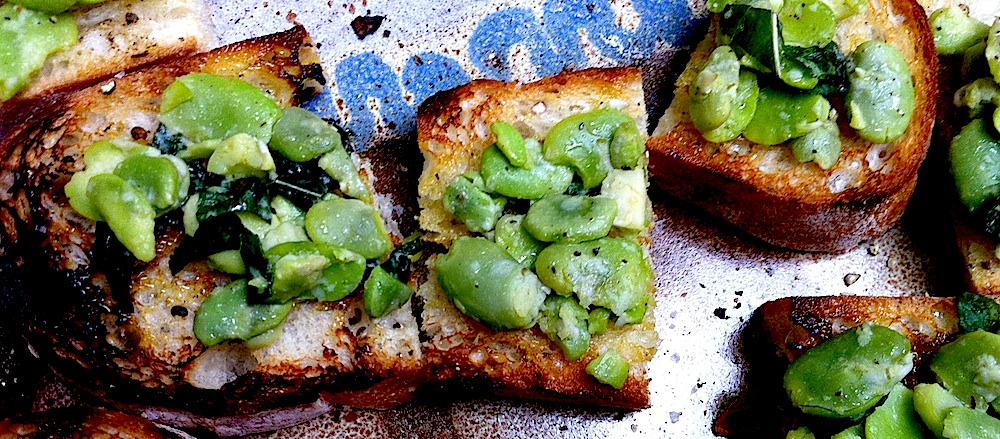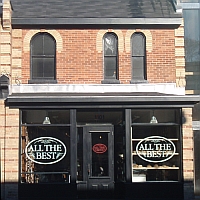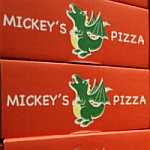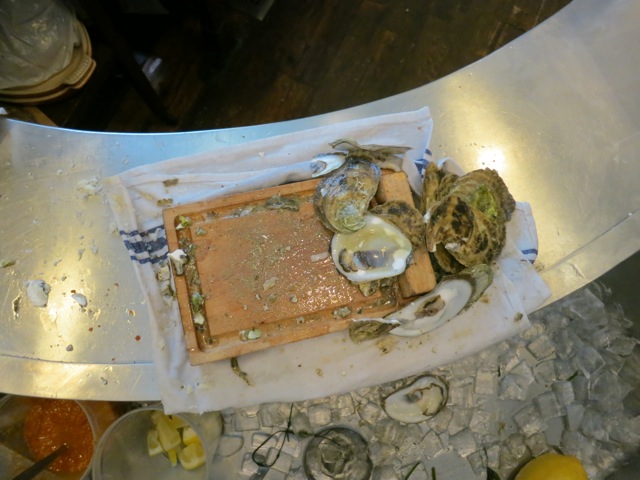by Emily Materick

Xococava’s Sicilian ice cream sandwich with Ontario rhubarb ice cream. A regular enjoys her weekend cone. Photos: Emily Materick
[This article is the second in a series. To read all of Emily Materick’s ‘Scoops’, click here. – Ed]
I recently had the fortune to interview chef Chris McDonald, co-owner of Cava and it’s little sister, Xococava – a unique confectionary shop that blends adult flavour with childlike whimsy. They offer seasonal tastes such as Ontario strawberry and wild blueberry maple alongside more adventurous inventions like saffron passionfruit white chocolate. Tucked inside the peaceful courtyard of Delisle Court, the petite boutique is frequently packed, full of both regulars and new visitors curious to try some of the sweet selections.
Recently, I have been lucky enough to begin working at Xococava and am learning the intricate balance and control that goes into a quality frozen product. The confections and ice creams clearly demonstrate Chris’ desire for pure flavour. This passion drove him to focus his training on the art of making ice cream which he developed under the tutelage of Hart Melvin, the Italian trained founder of Gelato Fresco. Now, the shop is two years old and continues to innovate new products and flavours throughout every season. I grabbed a few minutes of Chris’ time to get a more in-depth look at his motivations and examine the meaning of artisanal as it applies to ice cream.
EM: What made you decide to start making ice cream?
CMD: Well, everybody loves ice cream! What I like about cooking in general is all aspects – I like the raw products, I like the process –I like the amount of time the process takes which is a couple of days, maximum, usually, like if it’s a consommé it might take a couple of days. I like the things that take longer like salami. I’m fascinated by wine making, bacterial action, the way yeast works. Ice cream is very transformative in those ways. Part of what cooking is also about – and maybe it’s a guy thing – but I like the equipment. As a cook you’re always dealing with second rate, third rate, even fourth rate ice cream making equipment. As a chef in a fancy restaurant you’re making everything – your own bread, ice cream, pickles and all the rest so I think every accomplished cook hates the fact that they are working with a $500 or even $5000 ice cream machine.
What they want is a $50,000 ice cream machine that’s going to give you a perfect product, where the equipment isn’t holding you back and the only way that can pay for itself is to open an ice cream store! [Laughs.] So in a way, it’s a toy thing but you want the dreamy, Rolls Royce of ice cream machines at some point. I like the transformation but the transformation requires equipment. It’s not so much like baking where perfect bread can be made in a wood oven – ice cream needs a perfect machine in order to complete the process. The equipment is very neat and shiny and cool – like my bicycles. It’s an assemblage of moving parts that is fascinating to see work.
Why we opened up here is – I had my eye on the Delisle Court location for years and years, in fact I worked here in 1991, and next door was a Baskin Robbins. It made sense at the time because there were a couple theaters across the way and it was a different community, more kids in the area. There was a candy store as well that was here for about 15 years so it seemed like – ice cream, candy…I feel like people’s patterns don’t change that much and if they left then there’s probably some version that makes sense to be there. I thought well, the neighbourhood has very few kids living in it now so let’s do a confectionary shop – ice cream, candy – for adults. It’s kid friendly too but it services adults with Earl Grey bark and salted caramel and wacky bacon flavours. It’s an adults treat shop.
EM: What have you found the benefits are to being a small batch ice cream producer?
CMD: Well, we make it there and you get it. There are several enemies to ice cream. The most important is fluctuations in temperature and with small batch, we’re controlling the temperature in house which is the difference between (us and) some manufacturer that could be making perfect product with organic ingredients but you buy it in the supermarket and on it’s way from the manufacturer to the supermarket there’s a chance for temperature change. In fact, there will be – it’s inevitable. Then taking it home is another temperature change. It’s not so much the small batch that’s the factor, it’s that we babysitting the ice cream until you eat it. People buy half liters of ice cream and take them home, we don’t have control there but we have more control of the conditions than a large manufacturer.
EM: Making such an artisanal product, what challenges have you come across?
CMD: Artisanal – it’s a word that’s bandied about and in fact, I like it. Artisanal is a two pronged definition one of which is making things like once upon a time and making things the old fashioned way, with care. We use organic dairy, for instance but that suggests but does not define artisanal. It applies to a more careful, controlled fermentation like bread or meat, baking in an old fashioned style wood fired hearth. With ice cream, it doesn’t apply so much because the best ice cream will come from a 21st century ice cream making machine.
EM: Perhaps the difference between commercial ice creams and what you do here is that you babysit the ice cream until it gets to the customer; it requires a certain level of care.
CMD: It’s the difference between putting profit as the number one thing and having a profit spreadsheet as the way you write your recipes. Gelato Fresco, the owner is my mentor and teacher. Aside from the fact that he not choosing to use organic milk, he’s doing things in artisanal fashion as much as I am and (his business) is a factory. So, I mean, artisanal as it applies to ice cream is more about using high quality flavour ingredients and not putting profits first. Basically, putting profits first means using substitutes for dairy, for your fat and having high overrun which pumps up the product with air. That’s how it applies to ice cream but it’s not the same as charcuterie where non-artisanal would use artificial ways to age the meat. In baking, artificial ways to either speed up the process or lengthen the shelf life of the product. Artisanal doesn’t apply to ice cream in the same way. We’re honest but artisanal is not necessarily the right expression.
EM: I think the context that we’re looking at artisanal in this series are people who take the time and care to think about flavours, where the ingredients come from, using local ingredients – that’s more what we’re defining as an artisanal products. What do you usually look for when you are creating flavours?
CMD: I mean, you want the archetypal flavours – vanilla, chocolate, pistachio, and hazelnut – so you’re looking for the best flavour in those. We don’t have a lot of flavours to offer but twelve is about right, which is not very many in a typical ice cream store. What we’re finding is that a lot of people really go for the ice creams that have bits and stuff in them. Cookies and cream, black forest – flavours with chunks in them which is kind of the Ben & Jerry’s thing. While I don’t mind making them, I think of those as more kid type flavours and because I only have twelve flavours, the moment I do three of those I’m down to nine flavours. As a purist, it’s hard to give (those numbers) up. I like the flavours and they are actually fun to make but as a purist first every time we develop one of those flavours they tend to be a big seller and I lose one spot of my twelve to give people crème brulee, for example.
EM: Have you had any flavours that you’ve developed but weren’t easy to sell?
CMD: Liquorice caramel I love but it is not a big seller for us. It’s an extremely adult flavour but a lot of people don’t like liquorice. As a cook it’s important to like all flavours equally and to have an even palate, you have to try to have an open mind. I rather like liquorice but I don’t have to have it every week. It is a captivating flavour that you don’t get anywhere close with anything else so it’s very specific flavour – like truffles. It may not make the pantheon of twelve but I think liquorice caramel is kind of a really neat flavour. There are too many people who have just decided they don’t like liquorice so that would be the poor seller for me that has to go because people want cookies and cream.
EM: Due to using fruits that are in season, do you find yourself limited throughout the year, flavour wise?
CMD: Absolutely. In the Winter you can do fruit flavours but you’re doing preserved fruits, good Amerena cherries and boozy flavours. The prune and Pedro Jimenez we do is a bit of trademark but it’s clearly a Winter flavour. Just like cooking in a kitchen, you work with what’s in season and in the Winter there’s not that much. You get citrus fruits and we have lemons and storage fruits like pears so there’s always something. There is a seasonal quality to the store which is a suggestion of artisanal. The 1KM quince which comes from two 100 year old quince trees just down the street, every October (the owners) make the fruit available to me. Our fruit is mostly local but that’s our closest and most unique relationship, purveyor wise.
EM: What is your favorite flavour of the moment?
CMD: Vanilla. There’s nothing wrong with vanilla, a perfect vanilla.
EM: It’s true! Finally, there’s a debate among ice cream makers whether you should have an artisanal ice cream in a cup or a cone, that the cone distracts from the pure flavour of the ice cream. So, what are your thoughts – cup or cone?
CMD: It’s not about a cup or a cone. It’s about whether you’re using a spoon to put the food in your mouth or whether you’re putting your lips around ice cream. It’s the way in which you deliver the ice cream to your mouth. The cone is just a cookie vessel that holds the product. In a way the cone is a more perfect vessel because the way we eat ice cream out of a cone is without a spoon. It’s the spoon that is the issue, not the cone. It’s far more sensual to eat ice cream out of a cone because there’s no intervention of the spoon. You can throw away the cone when you’re done, it doesn’t matter. The cup is kind of perfect because you don’t have the infiltration of the cookie besmirching the flavour of your ice cream but in fact, the cone is the more perfect way to eat ice cream. It’s the difference between eating salad with a fork or with your fingers – it’s like fork changes the way the lettuce leaves, tossed in vinegar and oil, enter your mouth.
Xococava is located at 1560 Yonge Street. Visit the website at xococava.ca for more details.
 Emily Materick is a writer and the assistant pastry chef at Xococava. A voracious reader of food literature and a maker of tasty things, she also likes capturing those tasty things with her camera.
Emily Materick is a writer and the assistant pastry chef at Xococava. A voracious reader of food literature and a maker of tasty things, she also likes capturing those tasty things with her camera.







